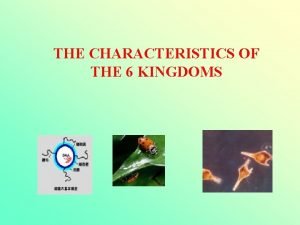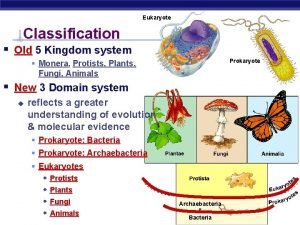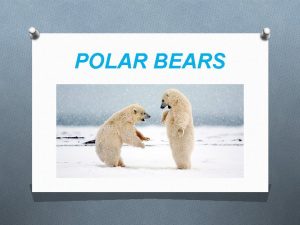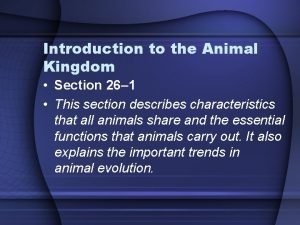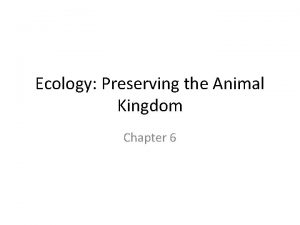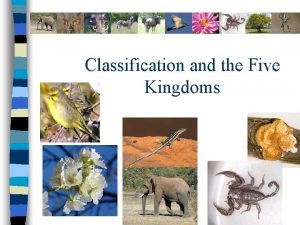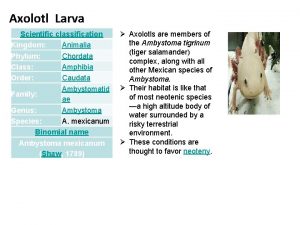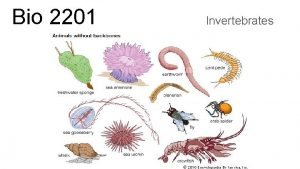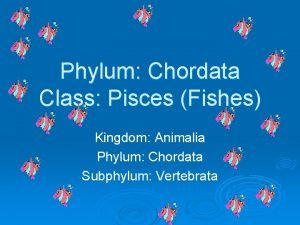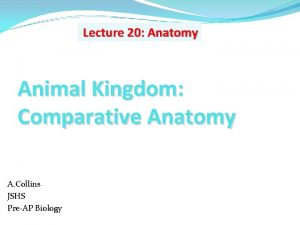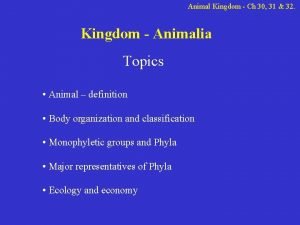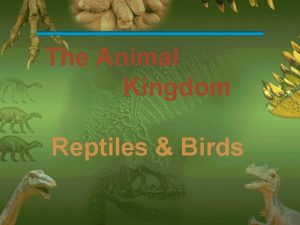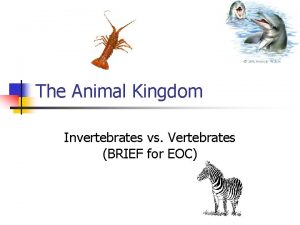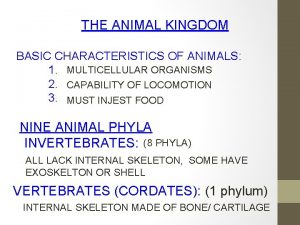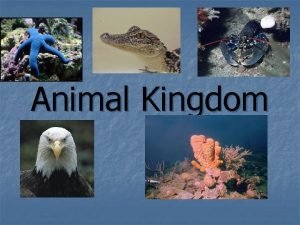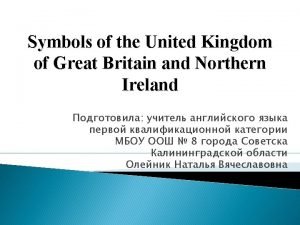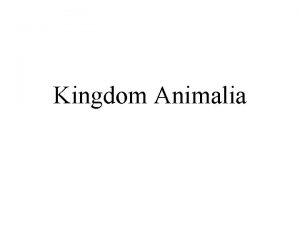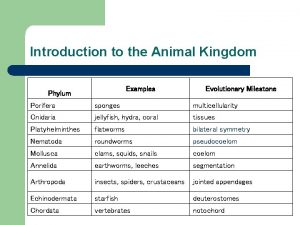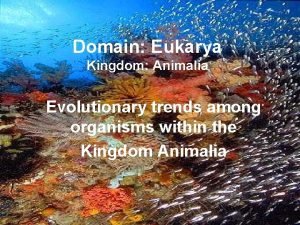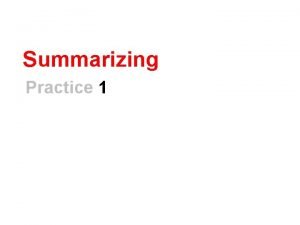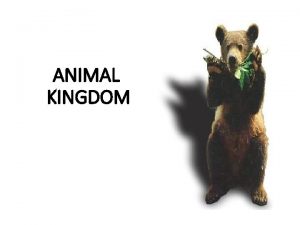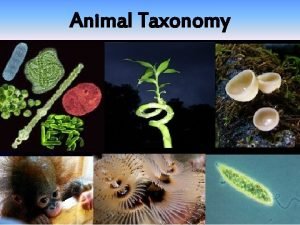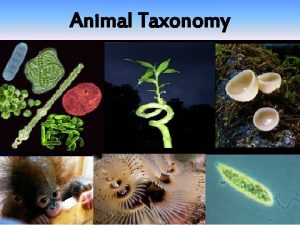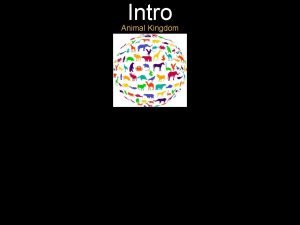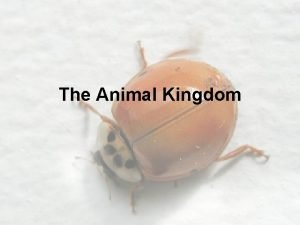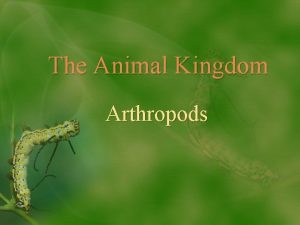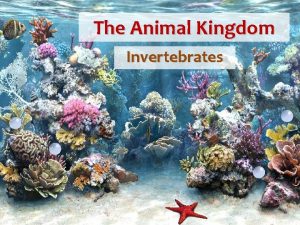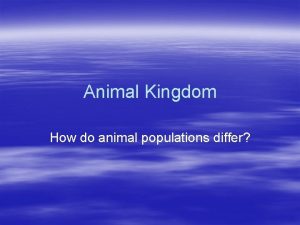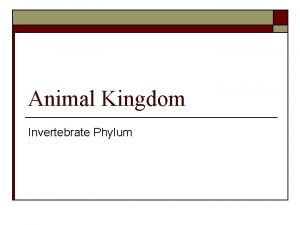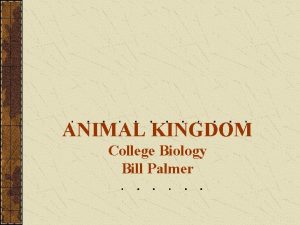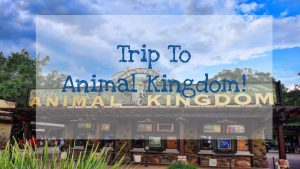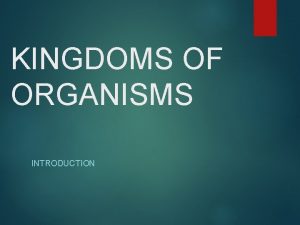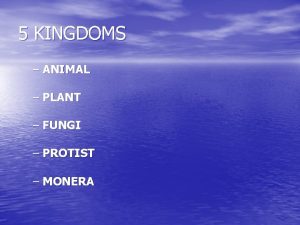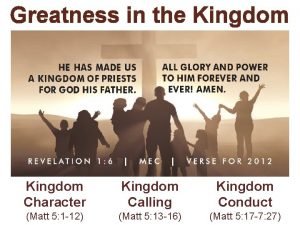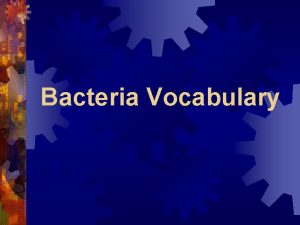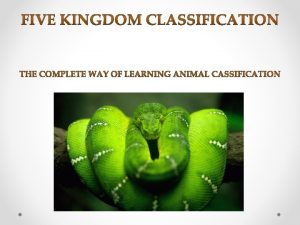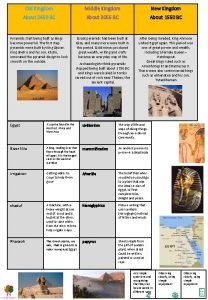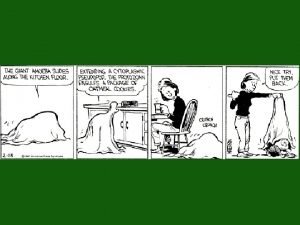The Animal Kingdom Of all the kingdoms of






































- Slides: 38

The Animal Kingdom • Of all the kingdoms of organisms, the animal kingdom is the most diverse in appearance. • So…. What Is an Animal?

• • • Animals are Multicellular. Animals are Eukaryotic heterotrophs. Animal cells lack cell walls. Animals belong to the kingdom Animalia. Animals must ingest food. Animals are capable of moving around.

Animals carry out the following essential functions… • Feeding and digestion (takes place in cells and in a digestive tract) • Respiration (gills, lungs, skin) • Circulation (open and closed systems) • Excretion • Response to outside stimuli • Movement • Reproduction

There are 9 animal phyla. • Invertebrates are animals without backbones. 8 of the animal phyla consist of invertebrates. • Vertebrates are animals with backbones. Only 1 animal phylum consists of vertebrates.

1. PORIFERA: SIMPLEST ANIMALS NO TISSUE LAYERS EXAMPLES: SPONGES


2. CNIDARIA HOLLOW BODY HAVE STINGING CELLS TWO BODY FORMS MEDUSA & POLYP EXAMPLES: CORAL, JELLYFISH, SEA ANEMONE


3. PLATYHELMINTHES: EXAMPLES: PLANARIA, FLUKE, TAPEWORM UNSEGMENTED WORMS FLAT WORMS



4. NEMATODA UNSEGMENTED WORMS ROUND WORMS EXAMPLES: HOOKWORMS, HEARTWORMS

5. ANNELIDA SEGMENTED WORMS MOST ADVANCED WORMS EXAMPLES: LEECH, EARTHWORMS



6. ARTHROPODA Invertebrate animals with exoskeletons made of chitin, a series of paired/jointed legs, and segmented body parts. Examples: Crustaceans (lobsters and crabs) Insects Arachnids

Characteristics of Arthropods • Open circulatory system: blood is pumped through a tubelike heart and into the body cavity (not contained in veins and arteries) • Molting: they shed old exoskeletons and grow new ones (see p. 732) • Insects undergo metamorphosis: incomplete or complete metamorphosis (see p. 744)

Incomplete Metamorphosis: process by which immature arthropods look similar to their adult form. Each time they molt, they become more and more like adults. In the last few stages of molting, they grow wings and sex organs.

Complete metamorphosis: process by which immature organisms change their body form before becoming an adult. Egg→ larvae → pupa →adult.

Arachnid

7. MOLLUSCA Mollusks have a complete digestive tract (consists of two openings: mouth and anus). They include gastropods, bivalves, and cephalopods. EXAMPLES: SNAIL, SCALLOP, OCTOPUS, MUSSELS



8. ECHINODERMATA HAVE A DERMAL SKELETON WITH SPINES & PLATES ONLY LIVE IN MARINE ENVIRONMENT EXAMPLES: SEA URCHIN, SEASTAR, BRITTLE STAR


9. CHORDATA (vertebrates) EXAMPLES: FISH, AMPHIBIANS , REPTILES, BIRDS, MAMMALS

Characteristics of Chordates (vertebrates) • Even though they are all very different, all chordates share the following 4 features at some stage of their development: 1. notochord: a flexible skeletal support rod embedded in the animal’s back 2. hollow nerve cord: runs along the animal’s back 3. pharyngeal slits: slits through the body wall in the pharynx (part of the gut immediately beyond the mouth). We have these as embryos. 4. tail: extends beyond the anal opening.

Other common characteristics… • • Endoskeletons Braincase Vertebrae Bones

All about fish…(p. 763 -767) • • • Vertebrates with gills and paired fins Live in the water Cold blooded 2 chamber hearts (1 atrium and 1 ventricle) Breathe through gills

All about amphibians…(p. 773777) • First tetrapods (animals with 4 limbs) • 3 chambered hearts (2 atria and 1 ventricle) • Need a source of water to reproduce

All about reptiles…(p. 793 -797) • Amniotic eggs: almost completely waterproof; prevent embryo from drying out • Covered in scales or plates • Live on land • Oviparous or viviparous • Cold blooded • 3 chambered hearts (2 atria and 1 ventricle) • Breathe with lungs


All about birds…(p. 798 -803) • • Evolved from dinosaurs Hollow bones (helps them fly) Amniotic eggs Breathe through lungs (air sacs are also located throughout their bodies-these are attached to the lungs) • 4 chambered hearts (2 atria and 2 ventricles)


All about mammals…(p. 805809) • • Hair or fur Mammary glands A middle ear containing 3 bones Jaws that allow them to chew food Warm blooded Breathe through 2 lungs 4 chambered hearts (2 atria and 2 ventricles)

More about mammals… • 3 types: 1. monotremes: mammals that lay eggs 2. marsupials: mammals that give birth to immature, underdeveloped live young that grow to maturity in a marsupium, or pouch 3. eutherian mammals: give birth to live young that have completed fetal development


 Old kingdom middle kingdom new kingdom
Old kingdom middle kingdom new kingdom Nnn ruled
Nnn ruled Roman empire
Roman empire Capital of egypt during the old kingdom
Capital of egypt during the old kingdom Types of phylum in animal kingdom
Types of phylum in animal kingdom 5 animal kingdoms
5 animal kingdoms Opposite rays
Opposite rays Similarities between protists and fungi
Similarities between protists and fungi Kingdom plantae characteristics
Kingdom plantae characteristics Plantae domain
Plantae domain What kingdom is considered the ods and ends kingdom?
What kingdom is considered the ods and ends kingdom? Polar bear curiosities
Polar bear curiosities Phylogenetic tree of 6 kingdoms
Phylogenetic tree of 6 kingdoms 26-1 introduction to the animal kingdom answer key
26-1 introduction to the animal kingdom answer key Horse taxonomy chart
Horse taxonomy chart Ecology preserving the animal kingdom
Ecology preserving the animal kingdom Order primates
Order primates What class is an axolotl
What class is an axolotl Animal kingdom cladogram
Animal kingdom cladogram Cladogram of the 6 kingdoms
Cladogram of the 6 kingdoms Morgan animal kingdom
Morgan animal kingdom Seizing
Seizing Subphylum pisces
Subphylum pisces Animal kingdom
Animal kingdom Canlıların sınıflandırılması
Canlıların sınıflandırılması Animal kingdom
Animal kingdom Reptiles order
Reptiles order Animal kingdom vertebrates and invertebrates
Animal kingdom vertebrates and invertebrates Basic characteristics of animals
Basic characteristics of animals Animal kingdom taxonomy chart
Animal kingdom taxonomy chart Animal classification domain
Animal classification domain Animal kingdom basis of classification
Animal kingdom basis of classification Invertebrates with bones
Invertebrates with bones National animal of britain
National animal of britain Characteristics of animals
Characteristics of animals Are humans in the animal kingdom
Are humans in the animal kingdom Coelom
Coelom Sea urchin phylum
Sea urchin phylum Yellowstone national park is mainly located in wyoming
Yellowstone national park is mainly located in wyoming




